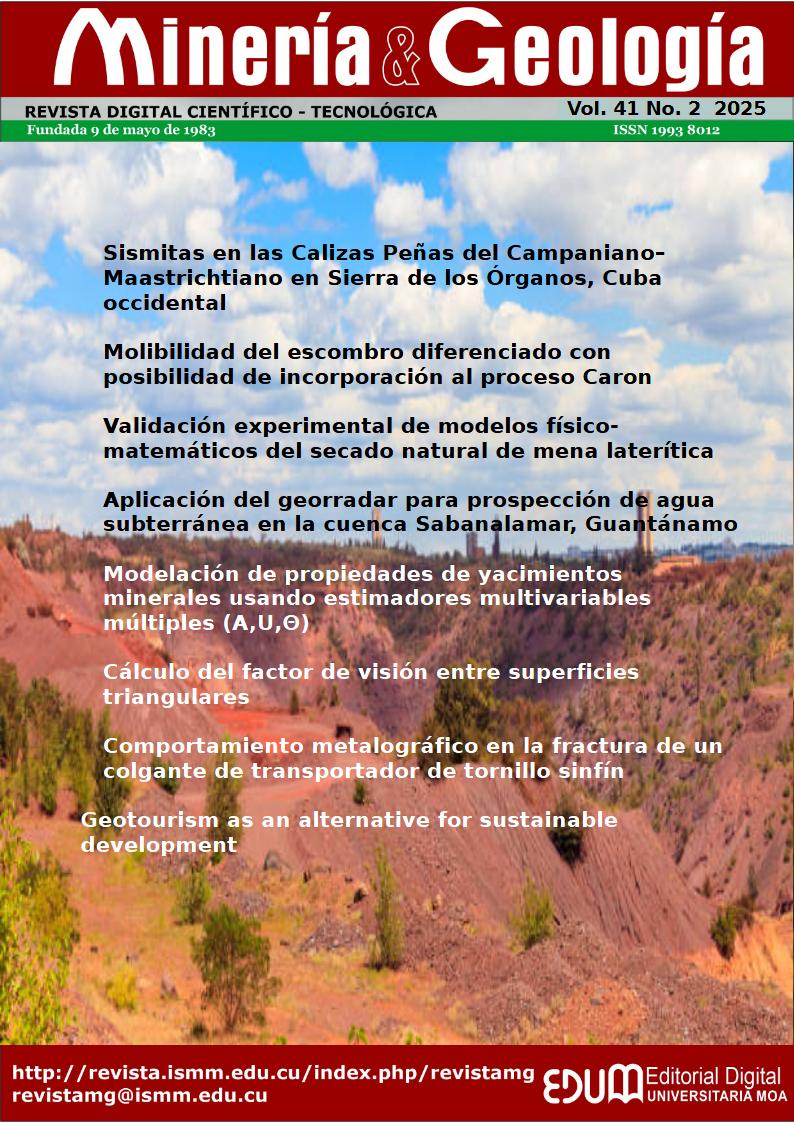Grindability of differentiated overburden with incorporating possibility to the Caron process
Keywords:
differentiate overburden, grinding kinetics, Caron processAbstract
The supply of lateritic overburden with nickel content lower and close to 0.9% - called differentiated overburden- constitutes a possible technological variant in the Caron process. The purpose of this research is determining the kinetic behavior of the grinding of the differentiated overburden, with the possibility of incorporating to the Caron process in Cuba, using the facilities of the conventional Bond mill of the Nickel Research Center. It was obtained that oxides and oxy-hydroxides of iron and aluminum minerals mixed with serpentines, prevail in the ore with Ni percentages of 0.845% and Fe of 40.50% that allow classifying it as differentiated overburden. The kinetic analysis of overburden milling process showed that the specific breakage rates are in the range of 0.89 min-1 to 0.20 min-1, with the highest values corresponding to the larger size fractions. The C and n parameters of the cumulative kinetic model resulted in 0.056738 and 0.384293 respectively, with a coefficient of determination higher than 88%.Downloads
References
Angulo-Palma, H. J., Legrá, Á. L., Urgellés, A. L., Pedrera, C. H., Gallegos, S., Galleguillos, M. F. M., & Toro, N. (2024). Use of a mixture of coal and oil as an additive for selective reduction of lateritic ore by the Caron process. Hemijska industrija, 78(1), 17-27. https://doi.org/10.2298/HEMIND230118017A.
Angulo-Palma, H. J., Legrá, A. L., Urgellés, A. L., Gálvez, E., & Castillo, J. (2022). Post-combustion Effect on Nickel and Cobalt Extractions from the Caron Process. In: Bindhu V., R. S. Tavares J. M., Ţălu Ş. (eds), Proceedings of Fourth International Conference on Inventive Material Science Applications. Advances in Sustainability Science and Technology. Springer, Singapore, 515-527. https://doi.org/10.1007/978-981-16-4321-7_43.
Bartzas, G., Tsakiridis, P. E., & Komnitsas, K. (2021). Nickel industry: Heavy metal (loid) s contamination-sources, environmental impacts and recent advances on waste valorization. Current Opinion in Environmental Science & Health, 21(100253), 1-9. https://doi.org/10.1016/j.coesh.2021.100253.
Caron, M. H. (1950). Fundamental and practical factors in ammonia leaching of nickel and cobalt ores. JOM-Journal of the Minerals, Metals and Materials Society, 2, 67-90. http://dx.doi.org/10.1007/BF03398981.
Coello-Velázquez, A. L. (2015). Procedimiento para la determinación de la carga circulante en circuitos cerrados de trituración y molienda. Minería & Geología, 31(2), 66-79.
Coello-Velázquez, A. L., Menéndez-Aguado, J. M., & Laborde-Brown, R. (2008). Grindability of lateritic nickel ores in Cuba. Powder technology, 182(1), 113-115. https://doi.org/10.1016/J.Powtec.2007.05.027.
Díaz-Bello, S. C. (2016). Modelamiento cinético del procesamiento de minerales lateríticos de níquel por vía pirometalúrgica. (Tesis Doctoral, Universidad Nacional de Colombia). 121 p.
Domènech, C., Galí, S., Villanova-de-Benavent, C., Soler, J. M., & Proenza, J. A. (2017). Reactive transport model of the formation of oxide-type Ni-laterite profiles (Punta Gorda, Moa Bay, Cuba). Mineralium Deposita, 52(7), 993-1010. https://doi.org/10.1007/s00126-017-0713-0.
Laborde-Brown, R. (2004). Diagnóstico energético en el proceso de molienda de la laterita. Minería & Geología, 20(3-4), 107-113.
Menéndez-Aguado, J. M., Coello-Velázquez, A. L. & Dzioba-Blanca, R. (2006). Process models for simulation of Bond tests. Mineral Processing and Extractive Metallurgy (Trans. Inst. Min Metall. C), 115(2), 1-7. https://doi.org/10.1179/174328506X99925.
Mitterecker, J., Košević, M., Stopic, S., Friedrich, B., Panić, V., Stevanović, J., & Mihailović, M. (2022). Electrochemical investigation of lateritic ore leaching solutions for Ni and Co ions extraction. Metals, 12(2), 325. https://doi.org/10.3390/met12020325.
Namindo, M. N. (2015). Cinética de la molienda del carbón bituminoso. (Trabajo de Diploma, Instituto Superior Minero Metalúrgico de Moa). 100 p.
Oxley, A., & Barcza, N. (2013). Hydro–pyro integration in the processing of nickel laterites. Minerals Engineering, 54, 2-13. https://doi.org/10.1016/j.mineng.2013.02.012.
Pintowantoro, S., Widyartha, A. B., Setiyorini, Y., & Abdul, F. (2021). Sodium thiosulfate and natural sulfur: novel potential additives for selective reduction of limonitic laterite ore. Journal of Sustainable Metallurgy, 7(2), 481-494. https://doi.org/10.1007/s40831-021-00352-4.
Sariol-López, E., Otaño-Noguel, J., & Belete-Fuentes, O. (2011). Procedimiento para estabilizar la calidad del mineral que se suministra al proceso metalúrgico en la planta niquelífera Pedro Soto Alba, Moa Nickel, SA. V Simposio Geología, Exploración y Explotación de las Lateritas Niquelíferas.
Tauler, E., Galí, S., Villanova-de-Benavent, C., Chang-Rodríguez, A., Núñez-Cambra, K., Khazaradze, G., & Proenza, J. A. (2023). Geochemistry and Mineralogy of the Clay-Type Ni-Laterite Deposit of San Felipe (Camagüey, Cuba). Minerals, 13(10), 1281. https://doi.org/https://doi.org/10.3390/min13101281.
Toirac-Leyva, V., & Rojas-Purón, A. (2021). Caracterización mineralógica de perfiles lateríticos del sector 048 en el yacimiento Punta Gorda, Holguín, Cuba. Ciencia & Futuro, 11(4), 23-37.
Véliz-Jardines, A. I., & Miranda-López, J. (2022). Desarrollo de investigaciones sobre la tecnología Caron durante el procesamiento de las lateritas de baja ley de níquel y de los escombros lateríticos, clasificados como: menas o minerales no industriales. Tecnología Química, 42(2), 361-383.
Zevgolis, E. N., & Daskalakis, K. A. (2022). The Nickel Production Methods from Laterites and the Greek Ferronickel Production among Them. Materials Proceedings, 5(1), 104. https://doi.org/10.3390/materproc202100510.
Published
How to Cite
Issue
Section
Copyright (c) 2025 Bárbara Fuentes-Herrera

This work is licensed under a Creative Commons Attribution-NonCommercial 4.0 International License.
- Authors retain copyright and guaranteeing the right magazine to be the first publication of the work as licensed under a Creative Commons Attribution-NonCommercial that allows others to share the work with an acknowledgment of the work's authorship and initial publication in this journal.
- Authors may establish separate supplemental agreements for the exclusive distribution version of the work published in the journal (eg, place it in an institutional repository or publish it in a book), with an acknowledgment of its initial publication in this journal.
- Authors are allowed and recommended to disseminate their work through the Internet (e.g., in institutional telematic archives or on their websites) before and during the submission process, which can produce interesting exchanges and increase citations of the published work. (See The effect of open access)










